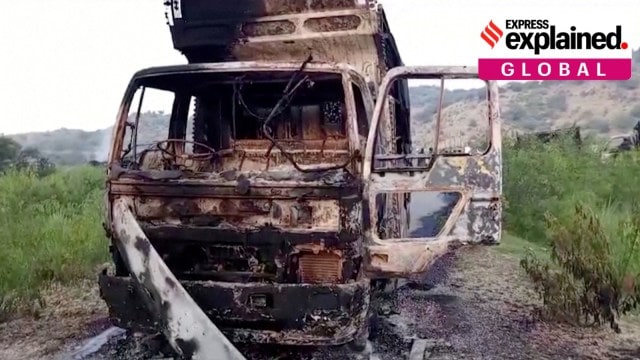Why Baloch militants targeted Punjabi travellers in recent attack which killed 23
Gunmen offloaded passengers from trucks and buses early on Monday in Balochistan’s Musakhail district, and shot them after checking their identities, an official said
 A charred vehicle, after separatist militants conducted deadly attacks, according to officials, in Balochistan province, Pakistan, August 26, 2024 (REUTERS)
A charred vehicle, after separatist militants conducted deadly attacks, according to officials, in Balochistan province, Pakistan, August 26, 2024 (REUTERS)Armed men stopped buses and trucks early Monday (August 26) morning in Balochistan’s Musakhail district, offloaded passengers and shot dead 23 people after checking their identities.
“Vehicles travelling to and from Punjab were inspected, and individuals from Punjab were identified and shot,” Musakhail Assistant Commissioner Najeeb Kakar said, according to Dawn. The militants also set fire to 10 vehicles, he said.
This is not the first such attack reported in Balochistan. In April this year, militants offloaded and shot dead nine Punjabi travellers near Balochistan’s Noshki city after checking their IDs. In October last year, six Punjabi labourers were shot dead in Balochistan’s Kech district in what authorities described as “targeted killings”. In 2015, gunmen killed 20 construction workers — all from Sindh and Punjab — in an attack on a labour camp near Turbat.
Why do Baloch militants target Punjabis? The answer to this question lies in the nature of the Pakistani state, and Balochistan’s complicated history with it.
Baloch insurgencies, and repression by Pakistani state
Since the birth of Pakistan, Balochistan has witnessed a series of bloody insurgencies, brutal state repression, and an enduring nationalist movement. The first insurgency began in 1948, after the forced accession to Pakistan of the chiefdom of Kalat, the largest and strongest of four chiefdoms that made up what would become the province of Balochistan.
The ‘Khan’ of Kalat had long advocated for an independent Baloch state. But British fears of Soviet expansion in the region, and Pakistan’s eagerness to consolidate as much territory as possible post the “losses” of the Partition spilt water on his dreams. The Khan signed the instrument of accession on March 27, 1948, a day after the Pakistan Army entered Baloch land to force his hand.
Soon, protests broke out against the accession. By July, Prince Abdul Karim, the Khan’s brother, had launched the first of five Baloch “wars of independence” — fought in 1948, 1958–59, 1962–63 and 1973–1977, and currently ongoing since 2003. These bloody insurgencies have perhaps been the biggest challenge to Pakistani sovereignty apart from the Bangladesh liberation movement.
They have thus been brutally repressed by the Pakistani state, with Pakistani forces accused of committing numerous atrocities, including abductions, torture, arbitrary arrests, and extra-judicial executions. While exact numbers are not available, conservative estimates suggest that tens of thousands of Baloch nationalists and innocent civilians have been killed by Pakistani forces since 1948. According to NGO Voice for Baloch Missing Persons, around 5,228 Baloch people have gone missing (presumed dead) in the period between 2001 and 2017 alone.
Baloch nationalist groups too have resorted to violence. They have been accused of various human rights violations including the attempted ethnic cleansing of non-Baloch people living in the province.
According to the ‘Pakistan Security Report 2023’ by the Pakistan Institute for Peace Studies, an Islamabad-based NGO, “Baloch insurgent groups, mainly the Baloch Liberation Army (BLA) and Balochistan Liberation Front (BLF), perpetrated 78 attacks in Balochistan killing 86 people and wounding 137 others” in 2023. These attacks were “spread over 19 districts, mainly in central, southern and southwestern parts of the province, and largely targeted security forces”.
The BLA has claimed responsibility for Monday’s attack, and warned of more such attacks, Reuters reported.
Behind targeting of Punjabis
What lies behind Baloch nationalism? And what has fuelled the insurgency for the past 75 years? Two factors stand out.
First is ethnic differences. This was the basis of Baloch nationalism at the time of Independence, and remains a crucial driver today. The Baloch people share a common history, language and culture, all central features of the birth of a national consciousness.
It does not help matters that since its very creation, the province of Punjab has dominated Pakistani politics, with Punjabis having a near unchallenged hold over the country’s bureaucracy and institutions. Even Pakistan’s cricket team has historically been dominated by Punjabis. For a country created solely on the basis of religion, ethnic differences have historically fuelled division and disunity, leading to the East Pakistan breaking away in 1971, and driving Baloch nationalism till date.
Second is a feeling of economic alienation and injustice held by the Baloch people. Balochistan is the largest — albeit most sparsely populated — province of Pakistan, abundant in natural resources (including oil), and strategically located on the country’s western border with Iran and Afghanistan. Yet its people remain relatively impoverished compared to the rest of the country.
This adds to the Baloch people’s sense of political disenfranchisement. Baloch nationalists argue that the Punjabi-dominated Pakistani state appropriates the fruits of Balochistan’s abundant natural resources. Take for instance the construction of the China-backed Gwadar port, a project which has garnered billions of dollars in investment but passed on little benefit to the local economy. Instead of educated and unemployed Balochi youth, Punjabi and Sindhi engineers and technical specialists, as well as Chinese experts, were hired en masse for the project.
The targeting of Punjabis in Balochistan takes place in this context. The dominance of Punjabis in the Pakistani state, the Baloch people’s continuing sense of injustice and alienation due to actions of this Punjab-dominated state, make people from Punjab prime targets for insurgents.
- 01
- 02
- 03
- 04
- 05






































